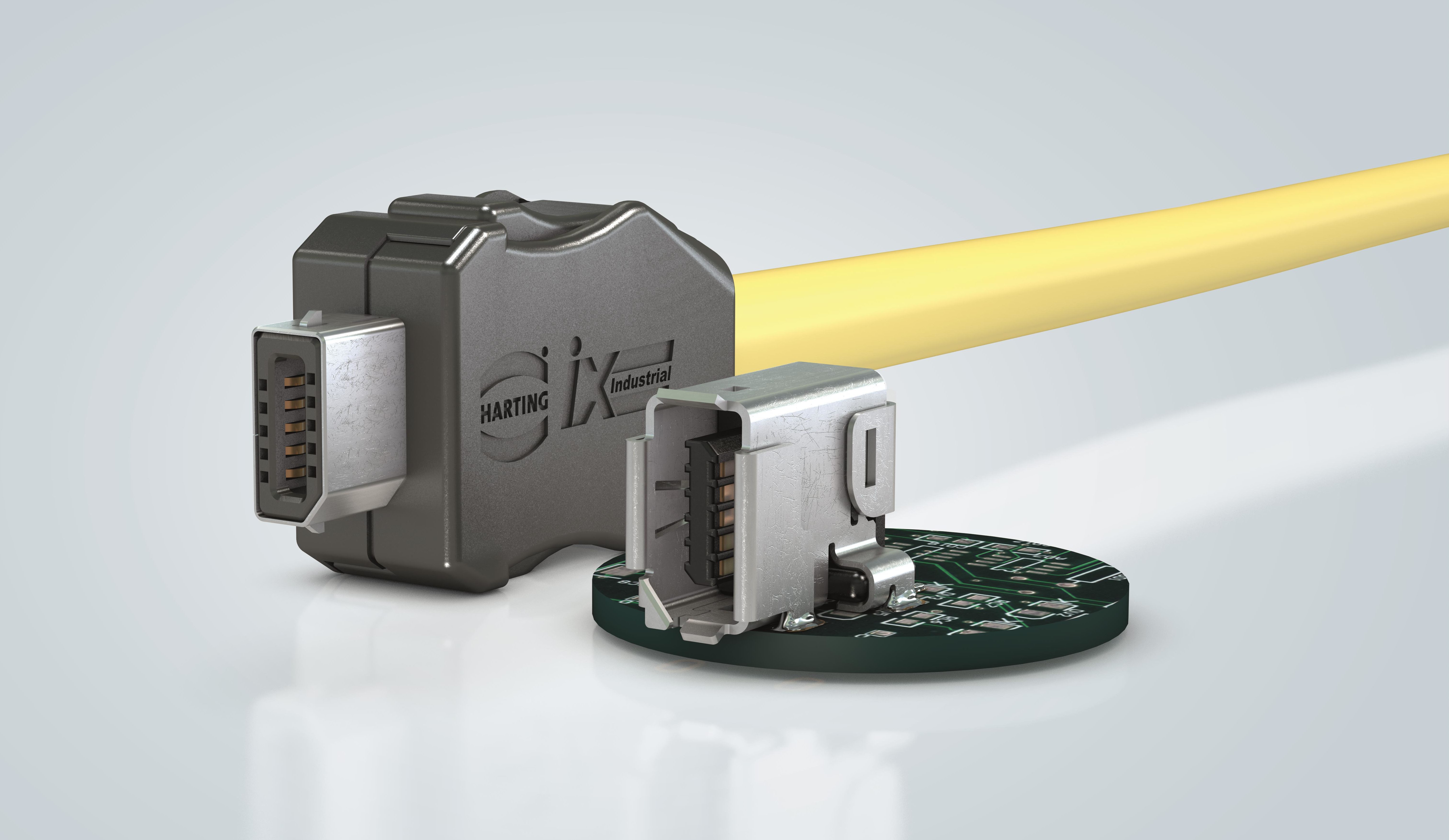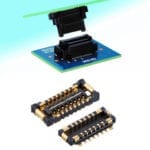Single-Pair Ethernet Will Revolutionize the Internet of Things
The new SPE connector standard will provide a comprehensive communication protocol, a shared networking infrastructure, and produce power for sensor technologies.
The T-1 industrial interface developed by HARTING is set to become the new single-pair Ethernet (SPE) connector standard. A united consortium of seven companies has approved the standard based on HARTING’s original design and it will be published as IEEE 802.3cg. HARTING, TE Connectivity, Hirose, Würth Elektronik, LEONI, Murrelektronik, and Softing IT Networks, the founding members of the SPE Industrial Partner Network, presented the SPE concept at the Hannover Messe and SPS trade events in November 2019. The new standard is expected to bring significant advantages to connected technologies as the Internet of Things (IoT) and Industry 4.0 expand their reach.
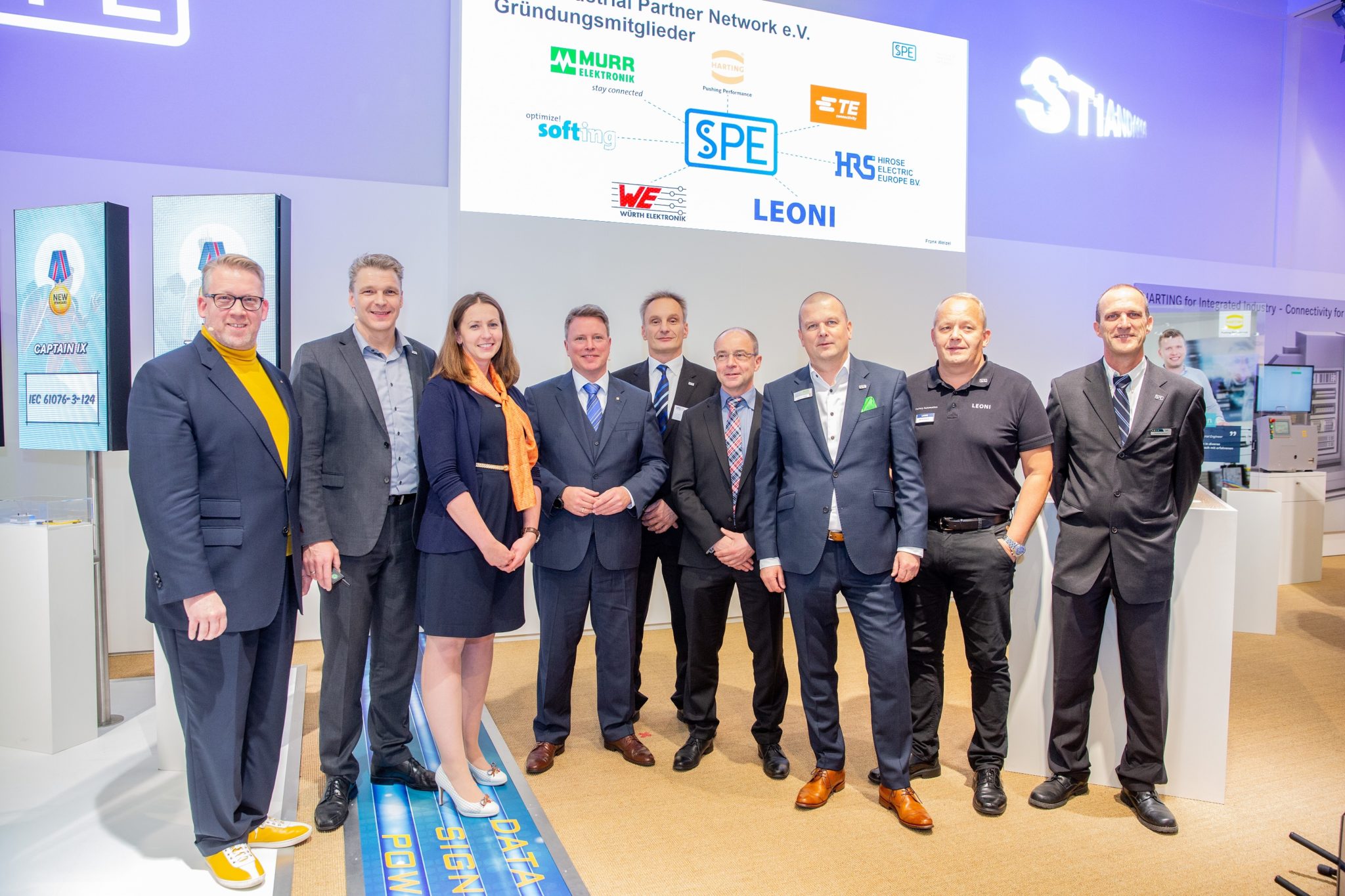
Members of the SPE Industrial Partner Network (from left to right): Edgar-Peter Düning (HARTING), Frank Welzel (HARTING), Monika Kuklok (TE Connectivity), Ralf Klein (HARTING), Armin Deinzer (Hirose), Alexander Gerfer (Würth Elektronik eiSos), Jürgen Zeltwanger (Murrelektronik), Peter Gerstenberger (LEONI) and Konstantin Hüdepohl (Softing IT Networks)
SPE enables the transmission of data by Ethernet using only one twisted pair. It is currently capable of transmission rates ranging from 10Mb/s to 1Gb/s for distances of up to 1,000 meters. With SPE, cabling can be streamlined by as much as 75%, saving weight, reducing costs, facilitating easer installation, and allowing designers to bring more functionality to compressed spaces. SPE connectors allow users to integrate Ethernet interfaces into simple sensors, cameras, and other reading and monitoring equipment. This streamlined technology helps ensure end-to-end compatibility across connected devices and ultimately will make the IoT devices and systems more capable and powerful.
“SPE is not just a collection of new infrastructure components, such as cables and connectors. SPE is a completely new ecosystem that influences devices and fields of application. For the first time, a single language can be spoken throughout, media breaks are avoided, and installation and implementation times are significantly reduced. By delivering data (Ethernet) and remote power (power-over-data lines) at the same time via the small, two-wire cables, it becomes smart,” said Jonas Diekmann, technical editor at HARTING. “A lot of devices and sensors won’t need an additional power supply or battery anymore. That’s good for the environment too.”
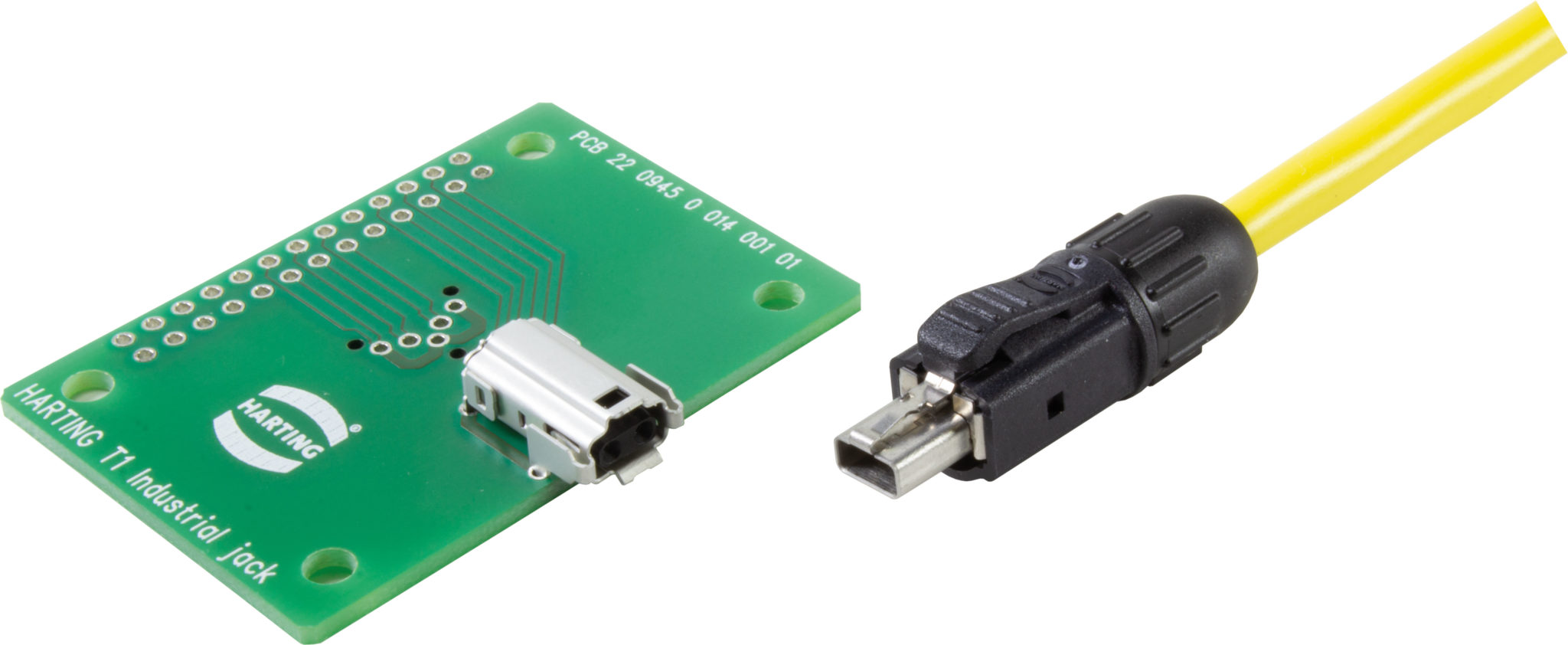
The HARTING T1 Industrial forms the basis for the development of the SPE interface.
Many industries are poised to see significant growth based on SPE’s ability to drive applications that need to be automated. The automotive industry is taking advantage of SPE for its Ethernet-based vehicle cameras, security systems, diagnostics, and autonomous technologies. SPE’s ability to reduce weight and cabling is a significant advantage to vehicle designers. The establishment of the SPE standard will enable it to impact industrial settings as well, including smart factories, smart city infrastructure, and automated building processes.
“SPE technology has been used in the automotive market since 2011. Now it comes to the industrial market as a simplified cabling system that will help make devises smaller,” said Takuya Fujimoto, deputy manager, industrial, global marketing, sales and marketing group with Hirose Electric Co., referring to the SPE-based 100BASE-T1 and 1000BASE-TI technologies that have been successfully integrated in automotive technologies. “Three years ago, we developed a new standard connector with HARTING called the ix Industrial, which features two or four twisted pairs. That connector is a miniaturized yet robust structure. It is mainly for industrial applications. The SPE connector is our next co-developed product with HARTING and it will have many more uses.”
SPE isn’t the perfect solution for every application. Minimizing the cabling has a limiting effect on data rate and range, making SPE ideal for space-limited applications.
Diekmann notes that SPE will not replace the eight-wire Ethernet infrastructure that is in now place in many applications. Instead, it will complement existing installations as new devices join existing systems. “A large number of new products will gradually incorporate the new possibilities of SPE. These will include new, smaller end devices and more powerful sensors, but also completely new infrastructure,” he said, noting that a common misunderstanding about SPE is the idea of cable sharing. “It makes more sense to replace and technically upgrade the field level by switching BUS applications to SPE.”
The companies involved in the rollout of SPE are available to support engineers as they prepare to integrate the interface into their designs or upgrade existing systems. “Seven strong brands founded the SPE Industrial Partner Network to combine their competencies in an open partner network,” said Sarah Hurst, marketing, Würth Elektronik. “The SPE Industrial Partner Network is a seal of quality for a uniform and coordinated infrastructure that meets set standards. This makes us the first point of contact for all questions and concerns regarding the construction of SPE networks and devices.”
In addition to the seven companies in the SPE Industrial Partner Network, Weidmüller, Phoenix Contact, Reichle & De-Massari, Belden, and Fluke Networks have been involved in the early development of the SPE standard and compatible products, including connectors, cables, switches, I/O modules, and cordsets. They emphasized the advantages SPE poses to industrial environments and other non-automotive applications. “The purpose of SPE is not to define new higher transmission speeds or distances; rather, it is to form the framework for standardizing reduced amounts of cabling for applications. This reduced cabling brings completely new areas of application into focus,” said Torsten Janwlecke, president of the business area device connectors at Phoenix Contact.
“We work together with a network of partners to consider the topic of SPE as holistically as possible for a wide variety of applications and to meet customer requirements in the areas of factory automation, process automation and building automation,” said Verena Neuhaus, business area device connectors, Phoenix Contact. “Our connector concept is based on the IEC 63171-2 standard for IP20 cabling and IEC 63171-5 for IP-protected cabling for industrial applications in M8 and M12.”
At Hannover Messe, the five companies presented products compatible with the SPE standard for office and industrial environments that feature pin connector patterns in accordance with the IEC 63171-2 (office environment) and IEC 63171-5 (industrial environment) standards. These standards define IP20 and IP65/67 pin connector patterns for single and four-pair data transmission in single-pair Ethernet applications. The companies are collaborating on standardized infrastructure for devices, connectors, cables, and measurement technology.
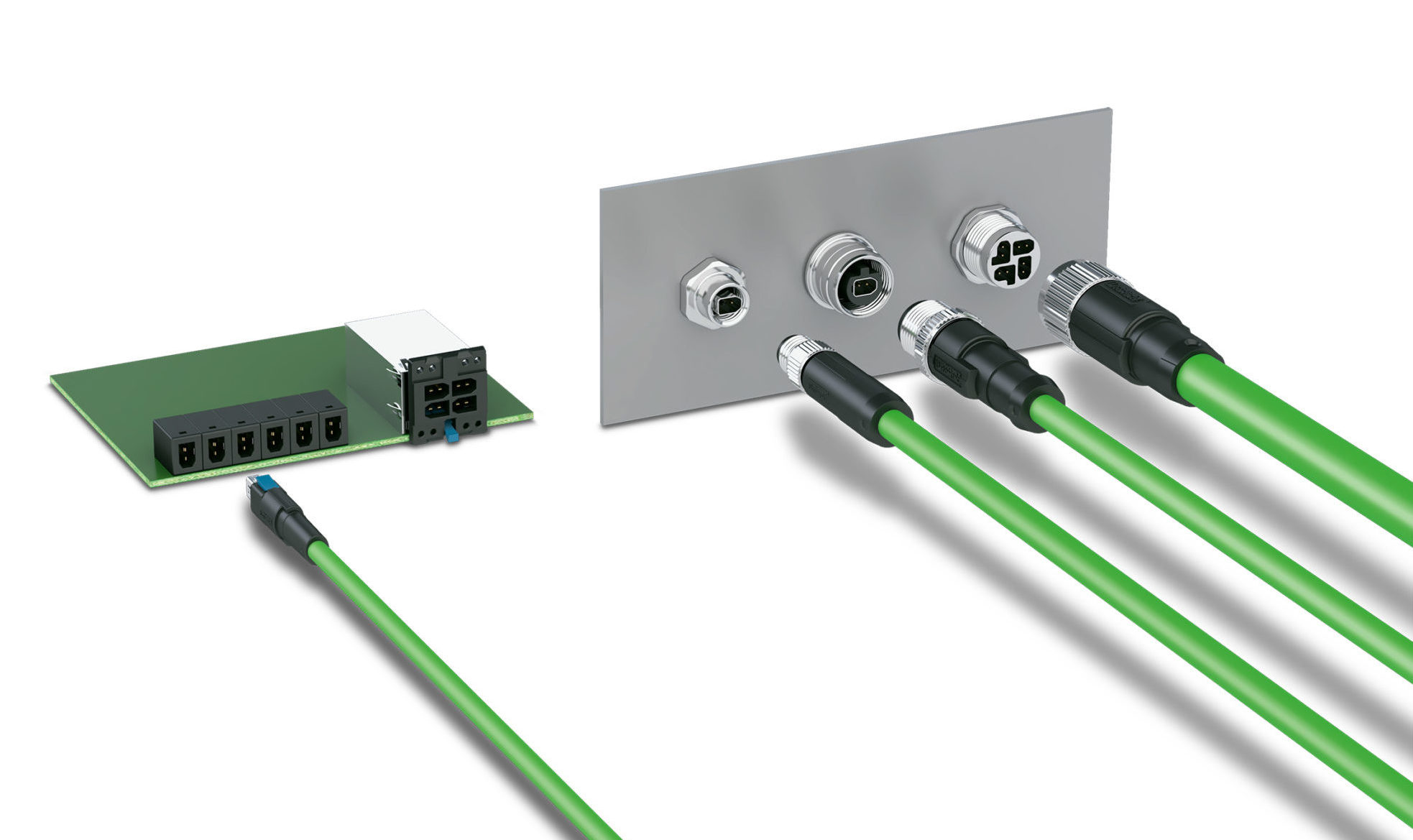
SPE cabling and pin patterns
“To be able to replace existing fieldbus systems, we will need components that are more cost-effective, more miniaturized, and more standardized. Here, single-pair Ethernet cables are playing a key role in the transmission technology,” said Berry Medendorp, director of global industrial marketing at Belden. Belden is currently developing new cable options that aim to improve data rates across longer distances. “The easy setup, smaller sizes, significant reduction in weight, and simple connection technology make this technology an interesting option in automation engineering, building cabling, railway engineering, and also in many other applications.”
Lighter, smaller, and more powerful designs can be expected across industries. The SPE interface will spur a burst of innovation that will impact every part of the electronics industry for years to come.
Like this article? Check out our other New Technology, standards, and IoT articles, our Datacom/Telecom and Sensors/Antennas Market Pages, and our 2019 Article Archive.
- Meet the Connector: DIN Standard Connectors - April 16, 2024
- Software-Driven Radio Reinvigorates Old Technology - April 9, 2024
- What is a Busbar? - April 2, 2024
